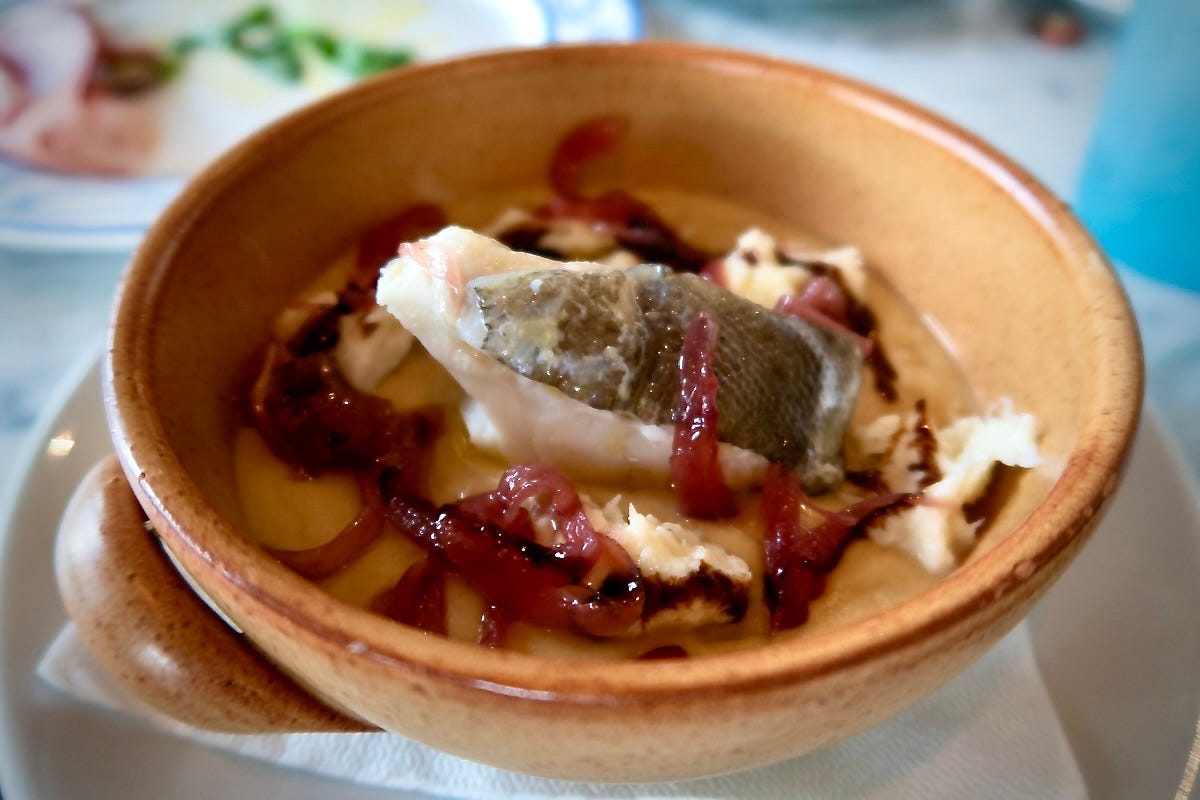Cod three ways + where to get real 🇺🇸 bagels in Rome
AND Italy's COVID restrictions are being rolled back soon
Cod - merluzzo in Italian - is a wonderful fish with a delicate flavor and flaky white flesh, often the protagonist in Britain’s beloved fish and chips. Italians love cod and it's a favorite fresh fish to serve children. In one form or another my husband and I probably have cod a number of times each month.
Cod lives in the colder waters of the north Atlantic and Pacific. The average cod weighs 5–12 kilograms (11–26 pounds).
The history of cod in Italy dates way back 1000 years ago when it was first brought to Italy as stockfish (photo above) and salt cod. Both of these preservation techniques made it possible for people to enjoy cod year-round, and it was an easy way to preserve and transport it.
Some of you might remember tales of grandparents giving their kids a tablespoonful of cod liver oil each day - a great boost to vitamin A, D, E and omega-3 fatty acids.
You can always find fresh cod and salt cod at Italian fishmongers. We usually steam or boil fresh cod for a few minutes and serve it drizzled with olive oil and a little bit of salt. It’s super easy to clean; the skin comes off easily and the cod flesh separates easily from the bones. It's a preferred fish to serve to young children in Italy because of its delicate flavor and because the bones are easy to remove.
In Italy fresh or frozen cod is known as merluzzo. When cod is cured by air-drying it’s called stoccafisso (stockfish - top photo) and when it’s salt-cured (salt cod - photo below) it’s called baccalà.
The word baccalà derives from a north German word, bakkel-jau, meaning salted fish.
I wondered where the name stockfish came from until I saw a photo of how it's air-dried. It's hung on a stick, or stock. Stockfish is air-dried but without salt preservation. This works well in a cold climate like Norway but in warmer climates like Spain and Italy salt curing works better.
Salt is used to cure and preserve lots of foods - prosciutto, anchovies, dried beef..… and cod.
Often at fishmongers in Rome you'll see salt cod and chickpeas next to each other. Romans make lots of delicious dishes with salt cod and chickpeas but both need soaking time in cold water. Salt cod has to be soaked and rinsed numerous times for many hours to remove the saltiness, and dried chickpeas simply need to soften to ready them for cooking.
Just a couple of weeks ago I had lunch with friends in Trevignano overlooking Lake Bracciano. I ordered salt cod and chickpeas. The chickpeas were puréed until creamy and smooth then topped with delicately cooked cod. For additional flavor and a hint of sweetness the dish was topped with caramelized red onions.
Depending on the time of year Romans love to serve salt cod with seasonal vegetables like this salt cod with winter artichokes.
Every region of Italy prepares fresh cod, salt cod and stockfish differently. Italians mostly use either fresh cod or salt cod in their recipes.
Venice is a little bit of an exception because they almost always use stockfish (stoccafisso), BUT they call it salt cod (baccalà). Venetians know they are preparing stoccafisso but they still call it baccalà. The Veneto-based Baccalà Brotherhood says it's strictly a pronunciation issue. Supposedly baccalà flows easier on the Venetian tongue than stoccafisso, and more closely resembles the native Venetian dialect.
When you visit Venice you'll find quite a few delicious stockfish recipes and one of my favorites is Baccalà Mantecato. If you're sampling cicchetti – Venetian appetizers - you'll find Baccalà Mantecato served on crusty bread or atop delicious sliced polenta. I love it both ways and it's so good I could eat it by the spoonful right from a bowl!
There are a few ways to prepare Baccalà Mantecato; here's the classic, historical recipe that dates back centuries.
Enjoying this post? Join the Flavor of Italy community for more like this with a 30-day free trial:
Baccalà Mantecato
Ingredients:
400 g stockfish
300 g extra-virgin olive oil
One unpeeled garlic clove
One lemon, halved
Three bay leaves
Salt and pepper to taste
Reserved stockfish cooking water
Preparation:
Soak the stockfish in cool water until the flesh is soft and plump.
Remove the skin and all the fish bones.
Boil the fish for 20 minutes in lightly salted water along with the unpeeled garlic clove, halved lemon, bay leaves and a half teaspoon of black pepper.
Drain the stockfish (make sure to set aside a cup of the cooking water) and place in a large mixing bowl.
Break up the fish into bite-sized pieces.
Gradually add the olive oil as you beat the fish vigorously with a wooden spoon.
The process is similar to preparing homemade mayonnaise.
Once you've beaten in all the olive oil the fish should have a creamy, whipped consistency.
If need be add a bit of the fish cooking water to make the mixture creamier.
Add salt and pepper to taste.
Serve the Baccalà Mantecato at room temperature on a slice of crusty bread or a slice of polenta.
Notes:
A wooden spoon works best but you can also use a sturdy wire whisk. A mixer isn’t ideal because you won't achieve the desired consistency, but in a pinch go ahead and use a mixer.
Stockfish isn't always easy to come by so you can substitute it with salt cod if need be. If so, make sure you soak the salt cod long enough to remove all of the saltiness.
One recipe variation that veers from the traditional recipe resembles the French dish, Brandade de Morue. For this variation use 200 g of extra-virgin olive oil and 100 g of warmed whole milk.
When you travel do you ever crave the taste of home?
I've been living in Italy for years and there are still things I miss and stock up on when I'm back in the States. When I'm stateside I eat lots of Mexican food, Thai food, American brunches and lots of bagels lathered with shmears.
During Covid lockdown the American couple Steve Brenner and Linda Martinez, owner of the Beehive hostel in Rome, decided to make breads and bagels and offer them to ex-pats craving a taste of home. Linda posted a message on social media to see if people were interested and the answer was a resounding, explosive yes! We're now well out of lockdown and in a Covid wind-down phase but the Beehive Bagel business is still going strong. In my Tuesday podcast episode with Steve and Linda we chatted about the ins and outs and the start-up of their Beehive Bagel business.
When you're next in Rome and craving a taste of home and a delicious bagel with shmears here's where to find Beehive Bagels.
Rollback of Covid restrictions in Italy
Just two days ago Italian Prime Minister Mario Draghi announced plans to roll back most of Italy’s Covid restrictions. Coronavirus cases are again on the rise with a positivity rate floating around 15% but despite this the government feels Italy can move towards a full re-opening and a gradual elimination of all Covid restrictions. Mario Draghi says that Italy's vaccination campaign has produced extraordinary results (Italy has some of the highest vaccination rates in Europe and worldwide) and he says "Italians have been very good in this pandemic” which leads the government to feel confident that a full reopening over the next few months can take place.
For the moment indoor mask wearing requirements will stay in place.
Here's a summary of the changes that will take place over the next six weeks:
1. On March 31 Italy will end its State of Emergency and disband the special committee of scientists that has overseen all government pandemic decisions over the past two years.
2. On April 1 unvaccinated workers age 50+, teachers and law enforcement professionals may return to work. Healthcare workers still must be vaccinated to work (this is expected to stay in place until December 31, 2022). Unvaccinated Italians age 50+ will still be fined if they refuse vaccination.
3. Beginning May 1 the green pass proof of vaccination or recent recovery from Covid will no longer be required for social, leisure, cultural or sporting activities in Italy like restaurants, health clubs and public transportation.
Tourist season is upon us and lots of you are planning to head to Italy for a visit, but you may still have Covid travel questions. You can check out this website to stay up-to-date on Covid restrictions within Italy, and for travelers to Italy. You can also call one of these numbers from abroad with questions: +39 0232008345 or +39 0283905385.
As of today travelers to Italy, whether from an EU or a non-EU country, can enter Italy with a valid vaccination, recovery, or test certificate. A valid vaccination certificate must prove that the primary vaccination occurred within the past nine months. Recovery certificates have a six month validity.
P.S…For all you paid Substack subscribers you'll soon be receiving your special snail mail postcard from Italy 🙌













For non EU travelers to Italy, will a Booster once again lengthen the validity of vaccination another 9 months from the time the booster was administered?
Thanks for your reply.